The following is a guest post by Donnie Summerlin, a Digital Projects Archivist at the University of Georgia Libraries in Athens, GA, and Kerry Huller, a Digital Conversion Specialist in the Serial and Government Publications Division at the Library of Congress. The University is also the National Digital Newspaper Program awardee for the state of Georgia.
Trees have always been a fixture of the American experience. In addition to their value as a natural resource, they have astonished and inspired with their beauty, strength, and longevity. Over the years, many of these trees have received attention for being present during important – and sometimes tragic – moments in American history. Newspapers have often played a role in cultivating the mythology of well-known American trees by reprinting accounts of their history and significance. In fact, a Nebraska newspaper editor established the first Arbor Day in the United States as a time to celebrate and plant trees. On this Arbor Day, let’s browse through the Chronicling America* newspaper collection to examine the fascinating stories behind some of the most famous American trees.
Liberty Tree
Boston, Massachusetts
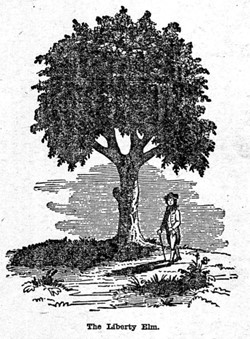
One of the most well-known trees to gain attention in the American colonies was the Liberty Tree in Boston, Massachusetts. This celebrated elm was planted in 1646, and over a century later, it became a symbol of freedom for American colonists in the years leading up to the Revolutionary War. When the British Parliament passed the Stamp Act in 1765, Bostonians gathered at the elm to protest the tax. The Tree of Liberty, as it came to be known, quickly emerged as a meeting spot for rebellious colonists who opposed British imposition, including the Sons of Liberty – the organization later responsible for the Boston Tea Party. When the Stamp Act was repealed in March 1766, colonists celebrated underneath the elm and decorated its branches with streamers and lanterns. Inspired by the events in Boston, patriots in cities across the colonies began christening their own “Liberty Trees.”
Unfortunately, the original Liberty Tree was a casualty of the American Revolution. During the siege of Boston in 1775, vengeful British soldiers and Loyalists chopped the tree down and used it for firewood. Although the tree is gone, it remains a celebrated symbol of the colonial era and continues to be memorialized for its role in the fight for American independence. There is a plaque with a carving of the Liberty Tree on a building at the corner of Washington and Essex Streets in Boston near where the elm once stood. The 1957 Disney movie Johnny Tremain featured the song “Liberty Tree” and Disney World in Orlando still has its own version of the tree growing in its Liberty Square.
Emancipation Oak
Hampton, Virginia
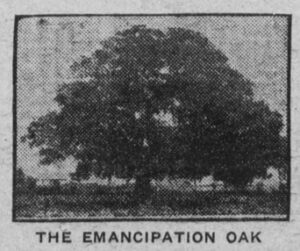
At the onset of the American Civil War in 1861, enslaved people living on the Virginia Peninsula sought sanctuary at Union-controlled Fort Monroe. The Union declared the refugees to be “contraband of war” and refused to return them to Confederate slaveholders. As a result, a growing community of formerly enslaved people grew up around the fort in a state that was still part of the Confederacy. The American Missionary Association (AMA) hired Mary S. Peake to serve as a teacher for the residents of the Grand Contraband Camp. She held classes for children during the day and for adults at night under the canopy of a large live oak tree that grew near the fort.
Even after Peake moved her classes into a cottage, the tree continued as a meeting spot for residents. In January 1863, the Emancipation Oak received its name when a crowd of enslaved and free Black residents gathered at the tree to hear one of the first public readings of the Emancipation Proclamation in the South. The breathtaking oak still stands near the entrance of Hampton University – a historically Black university that grew out of Peake’s pioneering work. With limbs that stretch over a hundred feet in diameter, the Emancipation Oak stands as a symbol of Black Americans’ fight for freedom and equality.
Johnny Appleseed’s Apple Trees
Midwestern United States
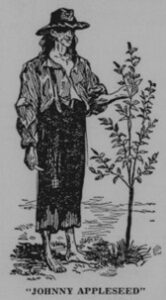
Johnny Appleseed is a popular figure among young children in the United States, but his story is rooted in the very real history of John Chapman’s travels through the Midwest in the early nineteenth century. Chapman was a nurseryman and missionary who planted thousands of apple seeds throughout Ohio and surrounding states. Contrary to popular belief, he didn’t plant the seeds randomly, but instead raised apple trees in nurseries and sold the saplings for profit. During his lifetime, Chapman became known as “Johnny Appleseed,” and he was famous for traveling the Midwest wearing a tin pot as a hat and carrying a bag full of seeds that he generously gave out to those in need.
Although there are a few cities in Ohio that claim to be the home of the last remaining Johnny Appleseed tree, most of his progeny are now gone. The legend of Johnny Appleseed and his environmental legacy, however, continue to live on through the American educational system where children learn about Chapman’s work and the value of trees to our planet.
The Tree That Owns Itself
Athens, Georgia
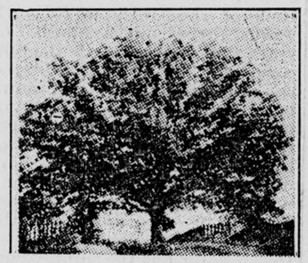
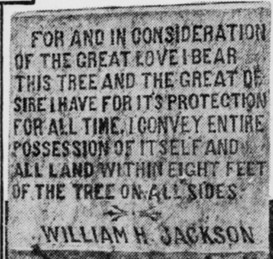
In the college town of Athens, Georgia there is a famous white oak tree with very curious property rights. According to local legend, Colonel William H. Jackson cared so much for a tree growing on his property that he deeded the oak and the surrounding land to itself in the early nineteenth century. The actual source of this remarkable story is a bit mysterious. No copy of the deed exists today and the first mention of the tree didn’t appear in Athens newspapers until 1890. In that news story, Jackson’s deed is quoted as saying “For and in consideration of the great love I bear this tree and the great desire I have for its protection for all time, I convey entire possession of itself and all land within eight feet of the tree on all sides.”
The Jackson Oak (as it is sometimes known) fell during a wind storm in October 1942 after years of declining health. A few years later, the Junior Ladies Garden Club of Athens identified a proper replacement sapling grown from one of the oak’s acorns and planted the offspring in the very spot where the original tree once stood. This new tree has the same name as its predecessor but is also sometimes called the “Son of The Tree That Owns Itself.” The oak continues to thrive on the land it owns near downtown Athens with a stone plaque that quotes Jackson’s deed.
General Sherman
Sequoia National Park, California
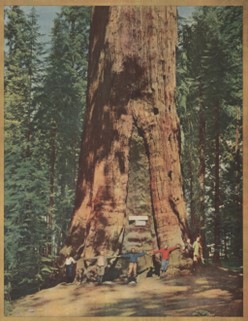
No list of famous American trees would be complete without including an entry from California, which has some of the oldest and largest trees in the country. Perhaps the most famous of California’s trees is General Sherman, a giant sequoia located in the Giant Forest of Sequoia National Park. Named after the American Civil War general, General Sherman has a trunk volume of over 52,000 cubic feet, making it the largest living single-stem tree on Earth. The colossal conifer is also one of the oldest American trees and is believed to be over 2,000 years old. General Sherman continues to grow at a rapid pace and its unmatched size and beauty have made it a must-see tree for tourists in the Golden State.
This is just a small sampling of the famous trees that have spread their branches across the United States. Do you have a celebrated tree where you live? Please share with us its story in the comments!
Search the Chronicling America newspaper collection for more stories about famous trees.
Search Strategies
Looking for coverage of the Liberty Tree on Chronicling America Start with the Advanced Search option on the Collection Items page. Along the top of the Advanced Search box, there are several radio buttons to choose between. To view individual newspaper pages where your keywords may appear, select the last radio button: Pages (Full Text). Just below the radio buttons is the field where you can enter your keywords. To the left of the keyword field is a dropdown menu that allows you to choose the type of search you want to complete. In this example, the Pages (Full Text) radio button has been selected, and “liberty tree” has been entered as a phrase search.

Maybe you want to narrow down your results because this search has returned coverage about a bunch of different liberty trees in various cities, and you’d really like to focus on the original tree in Boston. Try clicking on “+ Add Field” and enter “boston” as a secondary keyword. In the example below, the phrase “liberty tree” and the word “boston” will both be included on each newspaper page returned.

Additionally, you could try a proximity search, and enter “liberty tree” and “boston” as your keywords and choose to search for all of these words within 5 or 10 words of each other. Your results will be more likely to include newspaper pages where these words are located within the same article.

Or maybe you’d like to try and find coverage of the liberty tree published in Massachusetts newspapers only. In this case, try searching “liberty tree” as a phrase, and then select Massachusetts in the “State/Province” dropdown menu.

Keep in mind that while browsing an article about Boston’s Liberty Tree, you may find other terms like “liberty elm” to broaden your search. Or you may find references to other Liberty Trees, like the one in Annapolis, Maryland that you want to do a deep dive on too. And remember, you can search for “liberty tree” as a phrase with no other parameters, and then refine your search using the various facets on the left side of the page.

Sources
The Toombs Oak, The Tree That Owned Itself, and Other Chapters of Georgia by E. Merton Coulter (1966)
Civil War Places: Seeing the Conflict Through the Eyes of Its Leading Historians by Gary W. Gallagher and J. Matthew Gallman, eds. (2019)
Historic American Trees by Katharine Stanley Nicholson (1922)
The Largest Trees in the World. Sequoia & Kings Canyon National Parks, National Park Service.
* The Chronicling America historic newspapers online collection is a product of the National Digital Newspaper Program and jointly sponsored by the Library and the National Endowment for the Humanities. Follow Chronicling America on X @ChronAmLOC and click here to subscribe to Headlines & Heroes–it’s free!